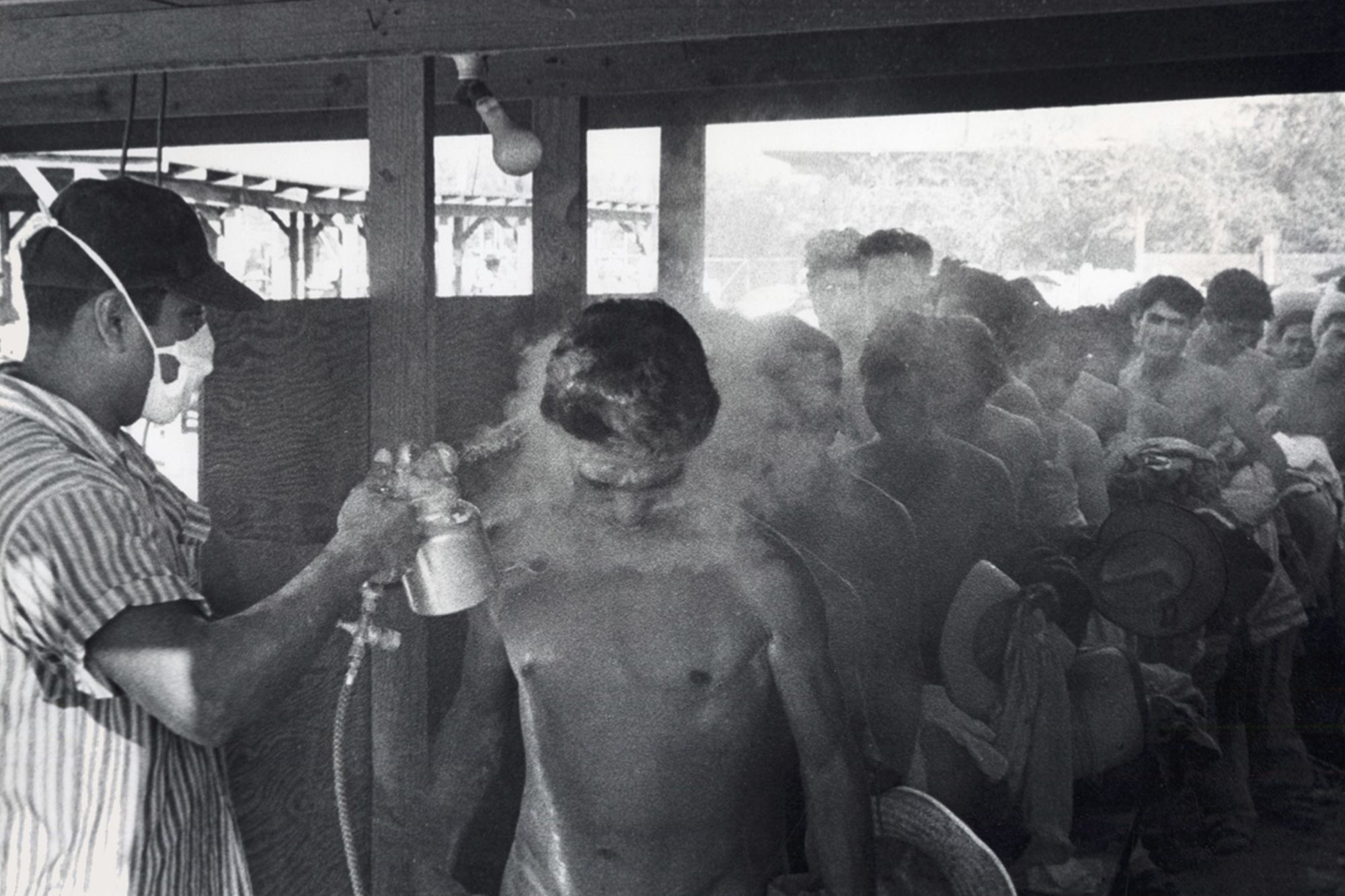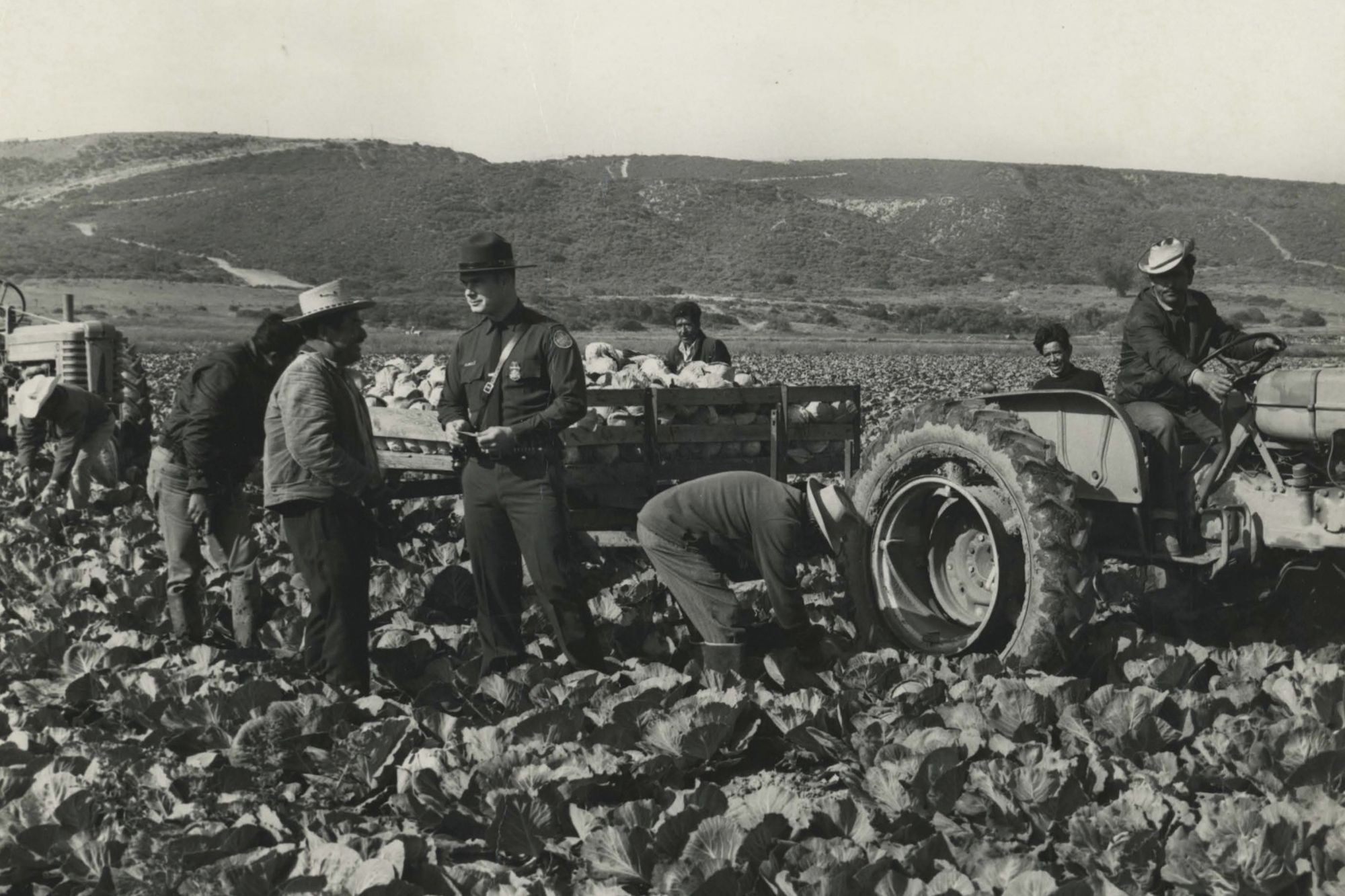CNN —
Some of Sebastian Corral’s memories have faded. But the 91-year-old remembers his 1953 arrival in the US as if it were yesterday.
How workers like him were forced to strip naked and sprayed with insecticide.
How their hands were inspected to make sure they were qualified for the hard labor that awaited them.
How unwelcome he and so many others felt even though they’d been invited across the border by the US government.
“You felt humiliated. You felt like you were nothing, even though you’d come to work and lift yourself up,” Corral told CNN in a recent interview via Zoom from his home in Vado, New Mexico.
Memories of those first moments in America came rushing back for Corral this month during a dramatically different visit to the place where he took his first steps in the country more than 70 years ago.
This time, officials were unveiling plaques designating the former Rio Vista Bracero Reception Center in Socorro, Texas, as a National Historic Landmark. And Corral was a guest of honor.
Corral and millions of others who crossed the border like him between 1942 and 1964 were known as braceros, a term derived from the Spanish word for arm and referencing the grueling labor participants in the Mexican Farm Worker Program would be doing upon arrival.
The partnership between the US and Mexico legally brought more than 4 million guest workers across the border to work largely in agriculture in 30 participating states across the country. The program purported to protect workers from discrimination. But the reality was much harsher for many braceros.

USCIS History Office and Library/Department of Homeland Security
This photo taken in Hidalgo, Texas, in 1956 shows a masked worker spraying braceros with DDT while others wait in line.
Years after the program ended, one of its former directors described it as “legalized slavery” in an interview with the Dallas Morning News.
“They were so fearful of being away from their homes and not sending money to their families that they felt pretty much in bondage,” former Department of Labor official Lee G. Williams told the newspaper.
The bracero program is an important chapter of US history that’s long been overlooked, according to Yolanda Chávez Leyva, an associate professor at the University of Texas at El Paso.
Many people aren’t aware of how significantly the program shaped immigration in the US, or the large number of families who can trace their roots in the US back to the initiative.
“It’s coming to light more, but it’s still not taught very often. History textbooks might have a paragraph on it,” Leyva says.
Even within former braceros’ families, she says, sometimes the history has been hidden.
“What they have told me is that they didn’t want to share their experiences with their families, because it was too painful, and they didn’t want their children and grandchildren to know what they had gone through,” says Leyva, who’s spent years collecting hundreds of oral histories from former participants in the program.
Blanca McCreary, one of Corral’s 14 grandchildren, says she only learned about his experience as a bracero when she was studying World War II in a college course.
“I asked him, ‘Do you know about this program?’ And from there is when he told me everything,” McCreary says. “And every time I hear him talk about it, I feel the same emotions. It makes me angry. I say, ‘How is it possible that they treated my grandpa like this? How is it possible that they treated them, as my grandpa says, like animals? These are human beings.’”

USCIS History Office and Library/Department of Homeland Security
Patrol agents check the papers of agricultural workers in the 1950s. While the bracero program provided a legal pathway for guest workers, crackdowns on illegal immigration were also common during that period.
Leyva says Corral and his story immediately came to mind when officials were planning the event at Rio Vista, and looking for a bracero to invite.
He’s one of the last known surviving braceros living in the region, Leyva says. Many have died in recent years, she says, especially during the pandemic.
Why Rio Vista is so significant – and rare
The Rio Vista site, a key hub for the program, is about a 30-minute drive from El Paso, Texas. It’s comprised of more than 20 buildings, including historic adobe barracks and wooden structures. And it’s the only one of five locations where braceros were processed that’s still standing.
According to a description on the National Trust for Historic Preservation website, more than 80,000 braceros passed annually through Rio Vista, where they were “met with terrible food, humiliating medical and psychological examinations and fumigation.”
USCIS History Office and Library/Department of Homeland Security
Aspiring braceros line up to undergo physical examinations by the US Public Health Service in South Texas in the 1950s. Their hats, bags and other belongings are piled nearby.
Corral says he was held at the site for several days before a rancher arrived and contracted him.
Over the years, the facilities — constructed in 1915 — have served a variety of purposes. Before its role in the bracero program, the area known as Rio Vista Farm was a poor farm and an orphanage. After the bracero program, it became a law enforcement training area, began housing some city offices and a community center, and even served as a set for the 2000 film “Traffic.”
Sehila Mota Casper, executive director of Latinos in Heritage Conservation, says she was amazed when she first discovered the site while working at the National Trust for Historic Preservation.
“Traditionally our sites have been demolished. They’ve been overlooked. They’ve been displaced, erased,” Mota Casper told reporters earlier this month. “To find out this building still exists was incredible.”
Courtesy Kip Malone/National Trust for Historic Preservation
Officials in Socorro plan to open the nation’s first Bracero History Museum at the Rio Vista site in 2027, with groundbreaking on the project slated for later this year. In the meantime, visitors can tour the site online or stop by in person to see the grounds with a visitor's pass from the city.
For years, Mota Casper, Leyva and city officials from Socorro pushed to get the Rio Vista site designated as a landmark. With that accomplished, now they’re working to turn it into the first Bracero History Museum in the United States.
Construction is slated to begin at the site later this year, with plans for the museum to open in 2027.
In Socorro, a small town outside El Paso, officials view the recent landmark designation as a major milestone.
“It’s like Ellis Island or the Alamo, what we have here, and it’s so prudent that we’re good stewards to make sure that we protect it and that we preserve it so others can appreciate it,” Victor Reta, the city’s director of recreation and historic preservation, told reporters.
The city also plans to open its first library at the site, and has been raising money for the project on its website.
Once the museum opens, Corral says he’s hoping many more Americans will visit Rio Vista and learn the legacy of the braceros.
“I want them to know that it wasn’t easy, what we lived here,” he says.
But Corral says he and many others felt like they had no other choice. In an oral history interview last year with the University of Texas at El Paso, Corral noted that farmworkers where he’d been living in Delicias, Mexico, made just 4 pesos a day. In the US, he could make eight times as much.
So Corral began his first three-month contract picking cotton on a farm in New Mexico and never looked back, though he returned regularly to Mexico to visit family. Corral continued as a bracero for 11 years until the program ended, then did everything he could to stay in the US and keep working.
Courtesy Corral family
Corral and his wife, Maria, married in Mexico in 1956. Three weeks later, he returned to the US to resume work as a bracero.
Today, he describes the long journey that began at Rio Vista with pride:
“I came as a bracero. After being a bracero, then I was illegal for some years. After being illegal, then I was a permanent resident. Now I am a citizen.”
In some ways, Rio Vista wasn’t like Corral remembered when he returned this month. The buildings were more worn-down — some “pure ruins,” Corral says. But what Corral noticed most wasn’t the buildings; it was how differently he felt being there.
“I was not the same person as before,” he says.
So much had changed since those first days when he was a young man waiting for a rancher to arrive at Rio Vista with work.
He’d harvested cotton, and driven tractors, and picked beets and cucumbers as a bracero. He’d lived in New Mexico, Colorado, Wyoming and Texas during his years in the program. Once, an El Paso restaurant had refused to serve him because he was Mexican. He’d been an undocumented immigrant for decades. He’d washed dishes and prepped food in a Los Angeles restaurant. He’d worked at dairy farms in California. He’d become a legal resident after President Reagan signed a law granting him and millions of others amnesty. He’d finally brought his wife and children to the US after years of separation. He’d saved enough money to buy land for all of them to build homes nearby. He’d had 14 grandchildren and 17 great-grandchildren.
And just two years ago, he’d finally become a US citizen after decades of knowing he was American, nearly 70 years after his first arrival in the United States.
All of this went through Corral’s mind as he revisited Rio Vista on May 11. And in the mix of emotions that hit him, he felt anger at some points, but also, contentment.
Some of the buildings around him were in ruins as they awaited renovation. But Corral was standing in the Rio Vista courtyard with generations of his family beside him.
And he saw something else: the life that he built.
Courtesy Fujiko Yamamoto
Four generations of the Corral family pose for a portrait at the Rio Vista site during a recent visit. Thinking back on his bracero experience, Corral says he’s proud he was able to work hard and support his family. "Something good came out of the bad," he says.